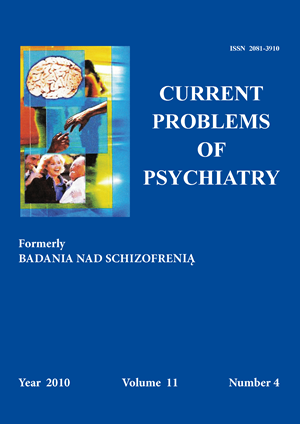Style radzenia sobie ze stresem u kobiet w ciąży prawidłowej i wysokiego ryzyka
Słowa kluczowe:
ciąża zagrożona, stres, ciąża prawidłowaAbstrakt
Wstęp: Ciąża zagrożona stanowi dla kobiety źródło wielu negatywnych emocji, zwłaszcza jeśli wymusza hospitalizację, co sprzyja powstawaniu stresu i może niekorzystnie wpłynąć na proces leczenia. Przedmiotem badań było określenie stylów radzenia sobie ze stresem u kobiet w ciąży zagrożonej i prawidłowej.
Materiał: Badania przeprowadzono w grupie 111 kobiet w okresie od marca 2008 do stycznia 2010. Kryteria włączenia pacjentek do badań były następujące: 1) pierwiastka, 2) wiek ciążowy do 32 tygodnia trwania ciąży. Grupa badana: 61 kobiet hospitalizowanych w Klinice Położnictwa i Patologii Ciąży Uniwersytetu Medycznego w Lublinie z nieprawidłowym, patologicznym przebiegiem ciąży. Grupa kontrolna: 50 kobiet w ciąży prawidłowej. Wszystkie kobiety miały około 28 lat, pochodziły z Lublina bądź okolic, w większości były mężatkami z wyższym lub średnim wykształceniem.
Metody: Dla określenia i porównania preferowanych stylów radzenia sobie ze stresem w obu grupach badanych użyto Kwestionariusza Radzenia Sobie w Sytuacjach Stresowych CISS.
Wyniki: Preferowanym stylem radzenia sobie w obu grupach okazał się SSZ (styl skoncentrowany na zadaniu). Nie stwierdzono różnicy istotnej statystycznie pomiędzy grupami. Drugi w kolejności styl radzenia sobie to SSU (skoncentrowany na unikaniu) - tu stwierdzono różnicę statystyczną na poziomie tendencji p=(0,09) na korzyść grupy badanej w składowej tego stylu, czyli ACZ (angażowanie się w czynności zastępcze), co oznacza, że pacjentki hospitalizowane w oddziale patologii ciąży, częściej niż w ciąży prawidłowej, unikały konfrontacji z sytuacją trudną angażując się w czynności inne niż koncentracja na problemie. Kolejny (pod względem wysokości wyników średnich surowych) styl w obu grupach to SSE (styl skoncentrowany na emocjach). Tu nie stwierdzono różnic istotnych statystycznie pomiędzy grupami.
Omówienie wyników: W obu badanych grupach kobiety wybierają styl skoncentrowany na zadaniu prawie tak samo często, jak skoncentrowany na unikaniu. Być może świadczy to o ambiwalencji emocjonalnej kobiet w ciąży. Częściej w grupie kobiet hospitalizowanych z powodu zagrożeń ciąży występuję tendencja do uciekania od problemu poprzez zajmowanie uwagi czynnościami zastępczymi.
Wnioski: 1. Ciąża zagrożona nie wpływa istotnie na konfrontację kobiet z sytuacją stresową. 2. Fakt hospitalizacji w ciąży wysokiego ryzyka może mieć wpływ na zmniejszenie tendencji do konfrontacji z sytuacją stresogenną oraz nasilenie reakcji ucieczkowych poprzez angażowanie się w czynności zastępcze.
Bibliografia
1. Ciesielski M., Michałek M., Szlapo E., Ścisłowicz K. Typy osobowości a zaburzenia emocjonalne u kobiet z patologicznym przebiegiem ciąży. Wiad. Lek., 1994; XLVII(1-2): 25- 30.
2. Kwaśniewska A., Kraczkowski J., Wartacz E., Robak J., Semczuk M. Ocena lęku oraz analiza struktury osobowości kobiet zagrożonych porodem przedwczesnym i porodem po terminie. Post. Psychiatr. Neur., 1996; 5: 185-193.
3. Pawełczyk A., Cypryk K., Bielawska-Batorowicz E. Poziom lęku i wieź emocjonalna z dzieckiem w okresie ciąży u kobiet zdrowych i z cukrzycą ciążową. Diabetol. Pol., 1999; 6(3): 189-192.
4. Kędziora S. Stres i radzenie sobie ze stresem przez kobiety ciężarne z niepowodzeniami położniczymi. W: Słomko Z., Brębowicz G., Gadzinowski J. i in. red., Kliniczna perinatologia i ginekologia. Suplement XIII, Poród Naturalny., Tychy: 1996, s. 183-187.
5. Michałek E., Ciesielski M. Dynamika objawów nerwicowych u pacjentek z patologicznym przebiegiem ciąży powikłanym nerwicą, jako efekt psychoterapii relaksacyjno-regulatywnej. Przegl. Psychol., 1986; 29(4): 1081-1087.
6. Łuczak-Wawrzyniak J., Pisarski T. Możliwości psychoprofilaktycznego przygotowania do porodu kobiet w ciąży po niepowodzeniach położniczych., W: Słomko Z., Brębowicz G., Gadzinowski J. i in. red., Kliniczna perinatologia i ginekologia. Suplement XIII, Poród Naturalny., Tychy: 1996, s. 135-138.
7. Strelau J., Jaworowska A., Wrześniewski K., Szczepaniak P. CISS. Kwestionariusz radzenia sobie w sytuacjach stresowych. Podręcznik. Pracownia Testów Psychologicznych; Warszawa: 2007.
8. Bogucka G., Pietrzak B, Marianowski L. Sposoby radzenia sobie z sytuacją trudną u pacjentek oddziału patologii ciąży. W: Słomko Z., Brębowicz G., Gadzinowski J. i in. red., Kliniczna perinatologia i ginekologia. Suplement XIII, Poród Naturalny., Tychy: 1996, s. 174-177.
9. Barańska M. Psychologiczne aspekty ciąży i porodu wysokiego ryzyka., Rodzina i Prokreacja. W: Chazan B. red., Materiały Konferencji Popowo 8-9 grudnia 1994., Instytut Matki i Dziecka, s. 66-71.
10. Czapiński J. Szczęście – złudzenie czy konieczność? Cebulowa teoria szczęścia w świetle nowych danych empirycznych. W: Kofta M., Szustrowa T. red., Złudzenia, które pozwalają żyć. Szkice z psychologii osobowości. PWN; Warszawa: 2001, s. 266-304.
11. Heszen-Niejodek I. Radzenie sobie z konfrontacją stresową. Wybrane zagadnienia. Nowiny Psychologiczne, 1992; 1-2: 13-26.
12. Kubacka-Jasiecka D. Z psychologii zmagania się ze stresem. Zachowania psychopatologiczne jako formy zmagania się ze stresem. Zeszyty Naukowe Uniwersytetu Jagiellońskiego MCLXVIII. Prace Psychologiczne, 1995; 12: 27-46.
13. Sędek G. Jak ludzie radzą sobie z sytuacjami na które nie ma rady? W: Kofta M., Szustrowa T. red., Złudzenia, które pozwalają żyć. Szkice z psychologii osobowości. PWN; Warszawa: 2001, s. 226-247.
14. Antonovsky A. Rozwikłanie tajemnicy zdrowia. Jak radzić sobie ze stresem i nie zachorować. Fundacja IPN; Warszawa: 2005.
15. Semczuk M., Steuden S., Szymona K. Ocena nasilenia i struktury stresu u rodziców w przypadkach ciąży wysokie-go ryzyka. Gin. Pol., 2004; 75(6): 418-424.


